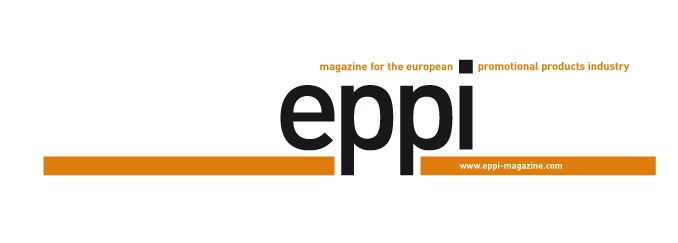In its capacity as the world’s largest sports movement for people with intellectual disabilities, the Special Olympics brings athletes from all over the globe together and asserts itself for more recognition and participation. In 2023, the Special Olympics World Games are being staged in Berlin. eppi magazine spoke with the CMO Albert Tuemann and Andrea Bury, who is primarily responsible for Merchandise and E-Commerce in the LOC (Organising Committee) of Berlin 2023, about marketing goals, about authenticity, identification and participation through the implementation of haptic advertising messengers, about queues in front of merchandising stands and irritation over sold-out XXXXL shirts.
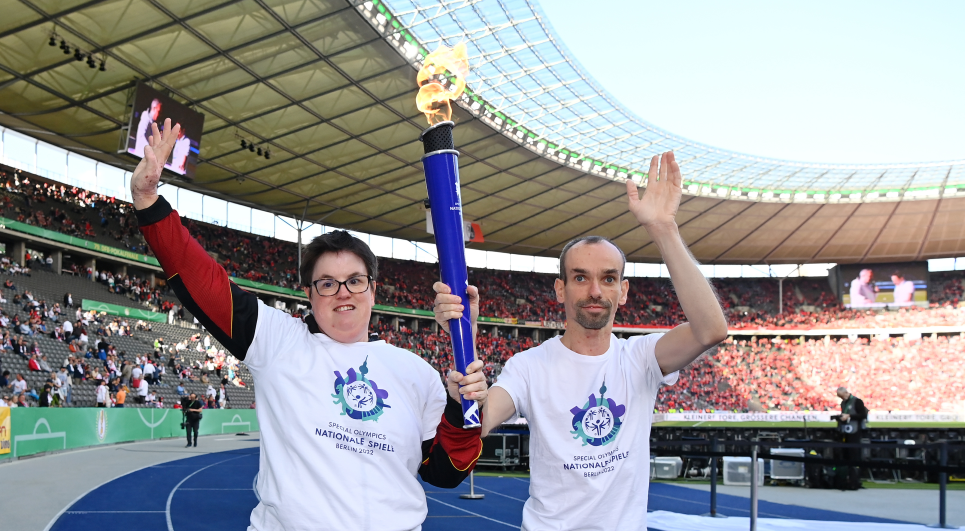
Mrs. Bury, Mr. Tuemann, as members of the Organising Committee of the Special Olympics World Games you strive to attract attention for the Games, but also for the movement itself. How often do people mix up the Special Olympics and the Paralympics?
Albert Tuemann: On the one hand, our communications serve as explanation: What are the Special Olympics? They are the world’s largest organisation for sports for intellectually disabled people. The association is called Special Olympics, the World Games that are staged every four years are the World Games of the Special Olympics movement. And on the other hand we do actually have to stress the differentiation, i.e. underline the difference to Paralympics sports and the Olympic Games. One of the main differences: People with intellectual or multiple disabilities take part in our competitions as well as so-called unified partners – i.e. people with and without disabilities together in one team – whilst athletes who suffer a physical disability or sight impairment are organised under the banner of Paralympic sports. Furthermore, we are involved more in mass sports, whereas the Paralympics and of course the Olympic Games focus on competition sport. In our case, all of the athletes are distinguished and receive a medal, not just the top three. And the athletes are divided up into different performance classes, so that the competitors of the different 100 m runs are for instance homogeneously grouped together based on their previous performances.
Andrea Bury
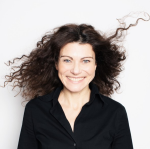 Born in 1970, after an international career in Marketing and Sponsoring (at among others Laureus World Sports Awards, Mercedes-Benz, O2, Formel 1) she founded the Fair Trade Lifestyle Label ABURY. At the Consultancy ABURY Positive Impact Lab she supports companies on the way to a more sustainable future. She is responsible for merchandising and E-Commerce at Berlin 2023.
Born in 1970, after an international career in Marketing and Sponsoring (at among others Laureus World Sports Awards, Mercedes-Benz, O2, Formel 1) she founded the Fair Trade Lifestyle Label ABURY. At the Consultancy ABURY Positive Impact Lab she supports companies on the way to a more sustainable future. She is responsible for merchandising and E-Commerce at Berlin 2023.
Albert Tuemann
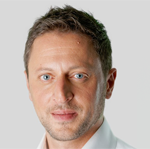 Born in 1972, after taking a degree in Economics at Berlin Technical University and diverse voluntary roles at associations in Berlin, he started his professional career at Lufthansa Systems. He has been working as a classic marketer and communicator for over 15 years, among others at Daimler, Skoda or FischerAppelt. He has been the CMO of the Special Olympics World Games Berlin 2023 since 2019.
Born in 1972, after taking a degree in Economics at Berlin Technical University and diverse voluntary roles at associations in Berlin, he started his professional career at Lufthansa Systems. He has been working as a classic marketer and communicator for over 15 years, among others at Daimler, Skoda or FischerAppelt. He has been the CMO of the Special Olympics World Games Berlin 2023 since 2019.
When it is necessary to carry out so much explanatory work, what are initially the overriding marketing goals?
Albert Tuemann: Unlike other organisations such as the UEFA, the FIFA or the IOC, the Special Olympics are not anywhere near as strictly organised. That gives us a high degree of freedom in the implementation, but it also means that we had no clear structures when I became the CMO and one of the five Executive Directors for Berlin 2023 in 2019 and the marketing was almost non-existent. So, first of all we thought about which basic vision we intended to follow with the World Games, how this could be brought into harmony with the association and then we jointly defined and refined the goals: Generating a more inclusive society through the uniting power of sport and the notion of how people with intellectual disabilities could ideally use improved structures for equal access to sports offers also after the Games, but also themes like education, culture and above all basic health care. Based on this we then addressed the classic “What?”, “How?”, “Why” questions, defined a mission and created a spirit that also aimed to inspire the internal communications. After all it is also about carrying along the approx. 200 persons in the LOC so that the team identifies itself with the task at hand. We want to assert all our strength for a more inclusive Germany, stand for more inclusive structures, we want to make the invisible visible. Our athletes are invisible, the movement is invisible. We want to make all of this more visible – together with the athletes.
This task is classic purpose-driven marketing: Which target groups do you want to address and via which channels?
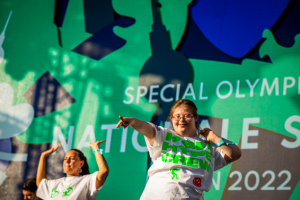 Albert Tuemann: We had classic market research carried out by Nielsen Sport in advance to find out who actually knows us and who our focused target group is. The athletes, their coaches and families know the movement. But if we want to gain more recognition and awareness, we have to address specifically those people who don’t know us yet. We then precisely classified around 35% of the German population, who we can reach because they are either interested in the theme major sporting events or are open to the theme inclusion as a whole. Among others, we have created our own social media channels and structures that also future organisers of the Olympics can build on. That took a lot of strength and energy. Another important aspect for us is to create more recognition, perception and understanding and to reduce fear of contact through encounters. This is why it was a matter close to my heart to integrate people with intellectual disabilities into our team, who take over totally normal jobs and tasks and serve to break down barriers. Unfortunately, many qualifiers and regional competitions had to be cancelled due to COVID, which meant we hardly managed to engage in encounters prior to the National Games. Merchandising and promotional products are indeed very important tools for addressing the target group.
Albert Tuemann: We had classic market research carried out by Nielsen Sport in advance to find out who actually knows us and who our focused target group is. The athletes, their coaches and families know the movement. But if we want to gain more recognition and awareness, we have to address specifically those people who don’t know us yet. We then precisely classified around 35% of the German population, who we can reach because they are either interested in the theme major sporting events or are open to the theme inclusion as a whole. Among others, we have created our own social media channels and structures that also future organisers of the Olympics can build on. That took a lot of strength and energy. Another important aspect for us is to create more recognition, perception and understanding and to reduce fear of contact through encounters. This is why it was a matter close to my heart to integrate people with intellectual disabilities into our team, who take over totally normal jobs and tasks and serve to break down barriers. Unfortunately, many qualifiers and regional competitions had to be cancelled due to COVID, which meant we hardly managed to engage in encounters prior to the National Games. Merchandising and promotional products are indeed very important tools for addressing the target group.
Why is merchandising so important?
Albert Tuemann: The identification with the merchandising items is immense within the athlete structure. One can hardly imagine it, but the first question when the athletes arrive in Berlin is: “Where do we get a T-shirt or a cap?”
Andrea Bury: That is total participation. One is simply part of the “inner circle”, when one is dressed right. I actually experienced myself at the National Games how the people were stood queuing at the merchandising stands. It was very moving. Many of them are simply delighted and pass on their unfiltered feedback, which is to 99% exuberantly positive. With the exception of those who are totally sad because their T-shirt is no longer available in XXXXL.
Albert Tuemann: Merchandising is just as important coming increasingly more significant. We use it very strongly for storytelling purposes and as a multiplier, for instance when we are out and about with sponsors, ambassadors or friends of the Games. For us merchandising is not so much a line of business, but instead more of a “fan” experience. As long as we don’t make a loss at the end of the day, that’s fine. It is much more about using the merchandising to increase the awareness for our theme.
Andrea Bury: We are definitely not out to achieve maximum profit, simply also because our target group actually also has certain financial resources. Our margin wouldn’t be acceptable in the normal fashion sector, but we actually want to make the products accessible. That is why we generate an incredible amount of communication and attraction in areas we are not normally involved in.
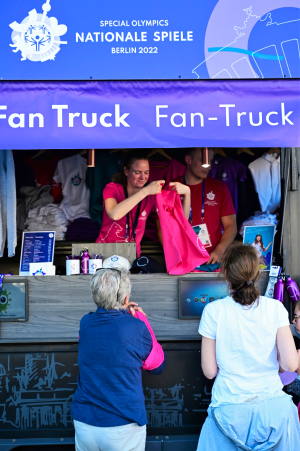
Besieged trucks: The fan items at the National Games in 2022 proved to be a big hit with the target group. Noticeable: Bright colours are more popular than discrete or black shades.
The central element of the merchandising concept is the online shop, which not only contains product descriptions, but also many stories about the products or the workshops for people with disabilities that partly make these products.
Albert Tuemann: We wanted to set the shop up differently to many other shops, where only key fobs, caps or T-shirts can be discovered and nothing else. We wanted to emotionalise the programme more strongly and we have built the product range based on three pillars: The classic collection, the integration of workshops for adapted work, which partly manufacture fantastic products and the involvement of athletes, who work together with designers.
Andrea Bury: We cooperated with the athletes on the development of the shop and designed a click dummy that was tested by the target group. This enabled us to see what difficulties they had, i.e. in finding certain information or products and we integrated the feedback into the end product.
The Special Olympics athletes play an active role in all of the activities. The logo of the Games wasn’t designed by an agency, but indeed by the participants of the Games themselves, wasn’t it?
Albert Tuemann: Yes, we have succeeded in achieving something that in my opinion hasn’t been appreciated highly enough yet by the public, namely the fact that we created the logo together with international and national athletes. With the support of an agency, we specified some signets and colours and then involved athletes in the course of digital workshops, asking them for instance which colour personifies the feeling of entering the stadium best, etc. This all takes a lot of time, but it creates a clear feeling of solidarity. The result was the logo, which was refined slightly by the accompanying agency, but which ultimately the target group for which the logo has been developed has contributed towards itself. Nobody can say: That is wrong. And if we receive the feedback from the athletes that they find it fantastic then we have done everything right.
There was a similar campaign where the multi award-winning fashion designer Anja Gockel had T-shirts designed in an inclusive workshop that have since been presented at the Fashion Week. What was the idea behind this?
Andrea Bury: Alongside sport we have also established music and fashion as further participation themes. Inclusion is also one of the top five trend themes in the classic fashion sector. We thought campaigning with Anja Gockel had a lot of potential for reaching new target groups. Three athletes designed a T-shirt together with her. They cut out parts of the logo and put them together in different sizes and colours. We documented the whole process with a really sweet film and played it on our online channels. Then, the T-shirt was printed in a workshop in Berlin and launched for the Fashion Week at the beginning of September, where all of Anja Gockel’s hostesses wore it. It really was about creating a story, not just a product. This is what turns a promotional product into an actual campaign, which can then be covered on other media. The great thing is that Anja Gockel also shares it on her social channels. That creates multiplier effects that are also exciting for us too because we receive recognition for the community from target groups that we wouldn’t otherwise reach.
In addition to the cooperation with designers, the collaboration with the workshops for adapted work is a central element of the merchandising programme of Berlin 2023 …
Andrea Bury: In order to further strengthen the identification, participation and authenticity, we naturally work together with the organisations where a lot of people with intellectual disabilities are employed. It is about creating awareness among the people, who don’t know us very well, that workshops for the disabled don’t just make brushes or the likes, but that they can actually create fantastic items, which they even win design awards for. We meanwhile work together with five workshops for the disabled, all of which are located in Berlin. The idea here is to also strengthen the local moment. Of course, it means one is also onsite faster and can develop something together ad hoc.
Which criteria are important to you when selecting the items for the online shop?
Andrea Bury: The people, who are interested in our themes, are among the conscious consumers, so sustainability is an important criterion when selecting the products, even if this is not always 100% implementable. We do however pay attention to internationally recognised certifications when selecting textiles and have items produced regionally where possible. We also create many products ourselves or cooperate together with designers and workshops. A really good product we have just initiated: We collected beach flags and banners from the National Games, are passing them on to a workshop and having a bag collection sewn out of them. This underlines our sustainability concept.
Beyond the classic merchandising: Where else is haptic advertising implemented?
Andrea Bury: We distribute goodie bags in the scope of cooperations with sponsors like Coca-Cola, Toyota, Nike, adidas. And apart from that we are present with stands at a wide range of different events. Haptic advertising is also implemented for our Volunteers programme – we have around 20,000 volunteers, who will help on-site at the World Games. We are also currently looking for retail partners, i.e. at the airport.
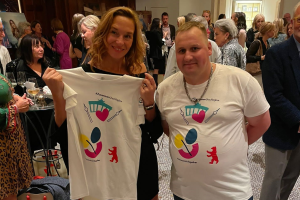
Three athletes cut out the logo of the Games in a workshop with the fashion designer, Anja Gockel, and pieced it together to form a new motif. The resulting T-shirt was presented to the public at the Fashion Week Berlin – with all-inclusive multiplier effects across the social media channels.
What are the reactions of the target group, which products go down well?
Andrea Bury: It is becoming obvious that colours are totally significant. Many colours that we perhaps wouldn’t tend to wear normally, go down very well, whereby the black sweatshirt really isn’t one of our bestsellers, I must be honest. Our aesthetic instinct is sometimes overridden here. But that is fabulous, one has to be prepared to go beyond one’s own limits. We are learning a great deal ourselves in that respect. The ceramic products from the workshop programme that often have an association with Berlin are very popular. They make lovely souvenirs. Badges are also in high demand. There is a large badge-trading community within the target group to.
What are your objectives for the Special Olympics 2023?
Andrea Bury: The web shop got off to a very successful start, but now we have to make sure we can maintain and further develop this success throughout the year. This storytelling is indeed a challenge, but also a huge opportunity for placing the themes inclusion and social participation. That is what I find so great about the whole project, that we have the chance to show how rewarding getting together with people with intellectual disabilities can be and that it pays off to open up a bit and push one’s own intellectual limits and get involved.
Albert Tuemann: Everything we do aims to heighten the communicative visibility of the Special Olympics, which in themselves without talking them down – after all it is the third largest sporting event in the world – are purely a vehicle for the actual goal: the participation and self-determination of people with intellectual disabilities. This is the target of all our activities.
// Mischa Delbrouck spoke with Andrea Bury and Albert Tuemann.
photos: Special Olympics World Games Berlin 2023
Special Olympics
The Special Olympics are the largest sports organisation for people with intellectual and multiple disabilities that is recognised by the IOC (International Olympic Committee). The movement was initiated in 1968 by Eunice Kennedy-Shriver, a sister of the former US President, John F. Kennedy, in order to enable people with an intellectual disability – like her older sister Rosemary Kennedy – more participation in social life. Worldwide just under 6 million athletes from over 200 nations are organised under the Special Olympics. Every four years the World Games of the Special Olympics movement, the third largest sporting event in the world comprising of 26 sports ranging from sailing, to football, through to bocce, are staged. The next World Summer Games are due to take place in Berlin in 2023.




